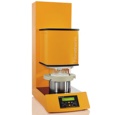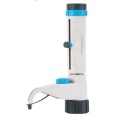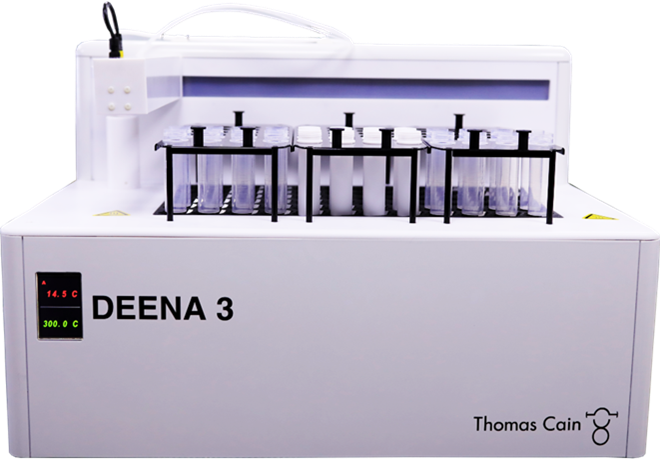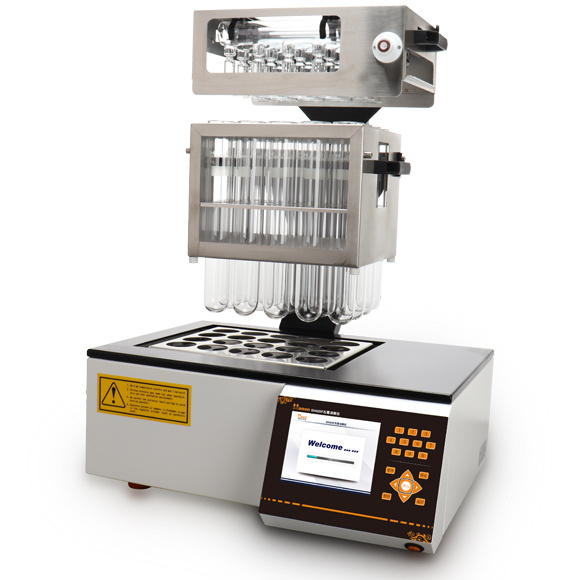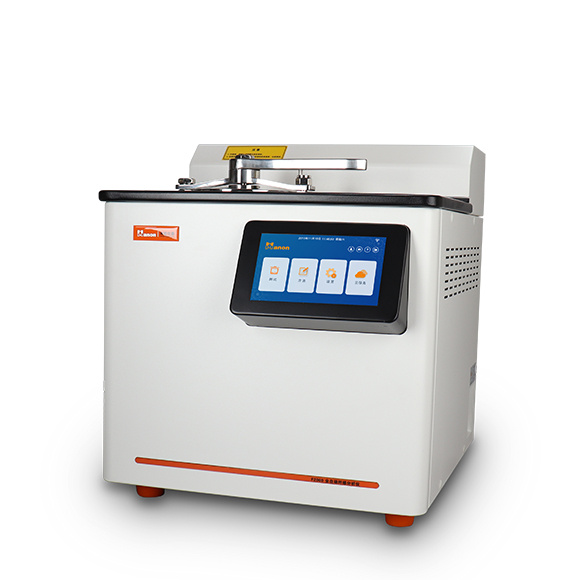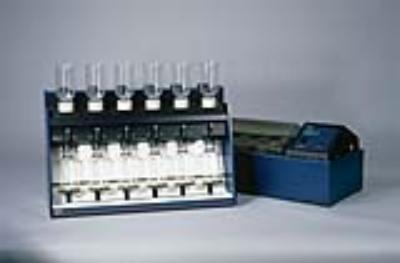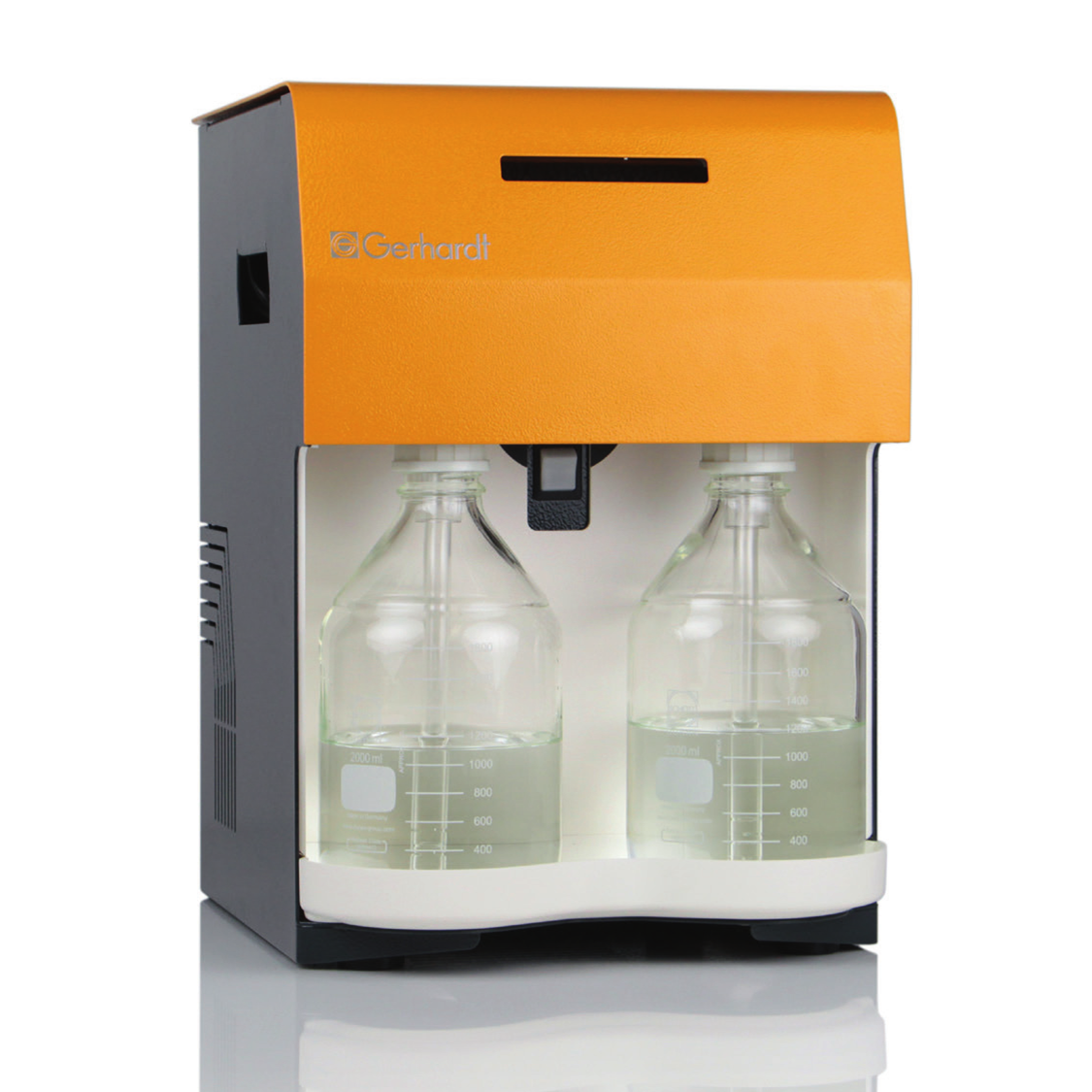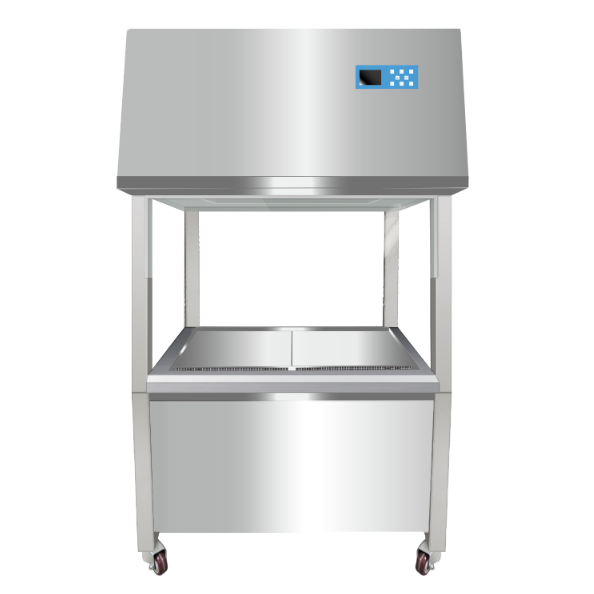方案详情
文
高粱大麦啤酒糟(SBBSG)代谢能含量和回肠氨基酸消化率对肉鸡生长、胴体和血液参数的影响EFFECT OF METABOLIZABLE ENERGY CONTENT AND ILEAL AMINO ACID DIGESTIBILITY OF SORGHUM-BARLEY BREWER'S SPENT GRAIN (SBBSG)
高粱大麦啤酒糟(SBBSG)和麦麸蛋白质消化率,高粱大麦啤酒糟(SBBSG)、玉米、豆粕、麦麸蛋白质脂肪及粗纤维含量的测定
方案详情

高粱大麦啤酒糟(SBBSG)代谢能含量和回肠氨基酸消化率对肉鸡生长、胴体和血液参数的影响EFFECT OF METABOLIZABLE ENERGY CONTENT AND ILEAL AMINO ACID DIGESTIBILITY OF SORGHUM-BARLEY BREWER'S SPENT GRAIN (SBBSG)高粱大麦啤酒糟(SBBSG)和麦麸蛋白质消化率,高粱大麦啤酒糟(SBBSG)、玉米、豆粕、麦麸蛋白质脂肪及粗纤维含量的测定2018 SCIENCELINEOnline Journal of Animal and Feed ResearchVolume 8, Issue 2: 20-32; Mar 25,2018 高粱大麦啤酒糟(SBBSG)代谢能含量和回肠氨基酸消化率对肉鸡生长、洞体和血液参数的影响 EFFECT OF METABOLIZABLE ENERGY CONTENT AND ILEAL AMINO ACID DIGESTIBILITY OF SORGHUM-BARLEY BREWER'S SPENT GRAIN (SBBSG) ON GROWTH, CARCASS AND BLOOD PARAMETERS IN BROILERS Thomas Nii Narku NORTEY1区 , Rejoyce FRIMPONG2 and Augustine NAAZIE1 1Department of Animal Science, College of Basic and Applied Sciences, University of Ghana, P. O. Box LG 226, Legon, Ghana 2Ga-West Dept. of Agriculture, Ministry of Food and Agriculture, P.O.Box AM 84, Amasaman, Accra Email : tnortey@ug.edu.gh ABSTRACT: The aim of this study was to determine the protein and amino acid digestibilities, and apparent metabolizable energy (AME) contents of sorghum-barley brewers' spent grain (SBBSG), use this information to formulate an appropriate diet for broilers, and determine the effect of SBBSG inclusion on growth, carcass and blood parameters. In experiment one f i f teen individually housed broilers were used to determine the apparent digestibilities of nutrients. Another cohort of 15 broilers were raised alongside and nutrient digestibility of key nut r ients in wheat bran determined. The AME of SBBSG (6.72 MJ/kg) was higher than previously assumed,whereas the digestibility values of some of the essential amino acids for SBBSG (Lys, Met, Phe, Thr and Val) were generally lower (42.93,71.6,55.47,75.26,and 62.66%) than previously assumed. In experiment two, diets were formulated based on nutrient availability values from trial one and fed to two hundred and fifty day-old chicks.Birds were allotted to five diets (TI, T2, T3, T4 and T5, representing 0, 4, 8 12 and 16% SBBSG, respectively).Average daily feed intake (ADFI) for birds on T1 and T2 were similar (105.6 and 102.3g) and these were higher (P<0.05) than ADFI for birds on T3 to T5 (92.2, 93.4 and 88.3 respectively). There were no treatment differences in average daily gain (ADG) and final body weight (FNBW). However as the level of dietary SBBSG increased, feed conversion efficiency (FCE) improved. Carcass parameters were not affected by the level of dietary SBBSG. Blood parameters were within acceptable ranges for broilers. It can be concluded that inclusion of SBBSG up to 16% in diets that are formulated based on nutrient availability, will have no adverse effects on broiler performance and blood profile. Results of this trial i ndicate that nutrient availability is key in effective feed formulation and broiler productivity. Keywords: Sorghum-Barley Brewers’Spent Grain, Digestibility, Performance, Blood Prof i le INTRODUCTION The broiler industry in Ghana faces severe challenges and its growth continues to be slow. Providing adequate and affordable nutrition for poultry and livestock poses a challenge to livestock production in developing countries like Ghana (FA O, 2011). The development of the poultry industry depends to a large extent on the availability of feedstuffs that are used or can be made suitable for use in poultry nutrition (On d w a sy e t al ., 2006). Feed costs alone can constitute up to about 70% of the total cost of production of poultry meat and eggs (B ab ik e r e t al.,2009).Feed prices in Ghana have been climbing primarily due to the fact that grains used in animal feed formulation, are the same grains that are used in human diets and in the breweries as well. The United States Department of Agriculture (USDA) estimates that in Ghana, the poultry industry consumes nearly 30 percent of all corn produced (U S DA ,2013). The competition and consequently, increase in the cost of feed and animal production (F AO, 2011)necessitates a reduction in the use of whole grain and cereals in monogastric diets with increasing emphasis on the use of cereal and Agro-Industrial by-products. Nutrients in these by-products must be packaged i n such a way that they can support monogastric production. Spent grain from the brewing industry is a typical example of such an ingredient. The bre ewing industry in Ghana generates large quantities of brewer’s spent grain . The composition of this by-product depends on the grain used in the brewing process. Generally however they tend to be high in some essential nutrients (including protein and essential amino acids and fats; M u ss a t to et a l .,2006) but have somewhat limited use in monogastric diets because of high fibre levels (N o rt ey et a l ., 2013; M anu-Ba rf o et a l ., 2013). Some of the larger breweries in Ghana use malted Sorghum as starting grains for their brewing operations. The resulting spent grain, So o i rghum-Barley Brewer’s Spent Grain (SBBSG), is unique and is used mainly by swine producers in the Kumasi Metropolis of Ghana as part of a wet-feeding regimen. Initial trials indicated that broilers fed SBBSG-based diets had improved growth rate, but the composition of this grain was mainly fat. Although the chemical composition of SBBSG, particularly amino acids, was determined and found to be high, its digestibility and availability to broilers was not determined (No rt e y et a l ., 2013). As a result of this, in the above mentioned trials,digestibility values for brewers spent grain reported by D onko r a n d Atto h - K o t ok u (2009) were used in the formulation of SBBSG based diets. Differences in digestibility values for different ingredients are important, as formulating diets on the basis of total nutrients rather than on digestible nutrients, resulting in wrong amino acid to Energy ratios, can result in excessive fat deposition (J acks on e t al., 1982). According to the National Research Council (N RC), availability of nutrients in different feed ingredients and ultimately in compounded feed is essential for the optimal production of birds (N RC, 2000). Information on the ability of a ration to supply digestible rather than total nutrients is necessary for accurate diet formulation (Ra v i nd r an, 2013). Digestibility of poultry diets is very important and can be a limiting factor governing energy and nutrient availability (Ad edo k un e t a l., 2007). Digestibility of nutrients present in a feed ingredient therefore needs to be quantified. However, there i s no information on nutrient digestibility of SBBSG in poultry. The hypothesis of this study therefore was that, when diets are formulated based on available, rather than on total amino acid and energy availability, SBBSG can be included in diets for broilers without negatively affecting growth, carcass composition and the health of birds. The specific objectives of the present study were: l) to determine the AME and ileal digestibilities of amino acids in SBBSG, Il) use the results obtained to formulate appropriate diets for broiler birds, and Ill) determine the digestibility of a comparable high-fibre ingredient (wheat bran). Results of the third objective were then compared to literature values and was intended to serve as a validation for the results obtained for the SBBSG digestibi l ity values. MATERIALS AND METHODS The anima l protocol used followed principles and ethical procedures recommended by the Institutiona l Animal Care and Use Committee of the Noguchi Memorial Institute for Medical Research, University of Ghana. The experiments were conducted in two phases. The first phase consisted of a digestibility trial and the second phase was a feeding trial. The two experiments were carried out at the Livestock and Poultry Research Centre (LIPREC), College of Basic and Applied Sciences (CBAS) of the University of Ghana (UG). Digestibility values obtained in the first experiment were used to formulate appropriate diets containing varying levels of SBBSG for a growth trial. The growth performance and carcass characteristics of broiler chickens fed these diets were then evaluated. The proximate chemical analysis of the feed ingredients and the compounded feed were done at the Nutrition Laboratory at the Department of Animal Science (DAS), CBAS-UG. Amino acid analysis was done at the Animal Science Department of the University of Illinois, United States of America. The analysis for protein and energy in the illeal digesta and the faecal samples of the individual birds were done at the Nutrition Laboratories of the Department of Animal Science (DAS), CBAS-UG and the Livestock and Poultry Research Centre (LIPREC). Feed Ingredients The SBBSG was obtained from the Kaase plant of Guiness Ghana Brewery Limited (GGBL) in Kumasi, Ghana Fresh material with an approximate moisture content of 95% was sun-dried for one week to a moisture content of 6%, ground through a hammer mill with a screen size of approximately 2mm, and stored until ready for use. The wheat bran was obtained from a local flour mill that sells this particular by-product on the open market to farmers. Animals and housing One hundred mixed sex COBB day-old broiler chicks were used as the starting point out of which 30 were used for digestibility trials. They were initially placed in deep litter pens and fed a commercial broiler starter diet from day one to day 21. On day 22 the birds were transferred to individual battery cages measuring 42x35x42cm (Lx B x H) where they were fed a broiler finisher diet till d 35. Determination of apparent metabolizable energy in SBBSG and wheat bran On d 36, an initial group of 30 individually housed broilers were used for the determination of apparent metabolizable energy contents in SBBSG and wheat bran (15 birds per ingredient). Birds were fed ad libitum on a broiler finisher diet for 1 week prior to force-feeding (S i b b ald , 1986). Collection trays were fixed to the individual cages, the birds were fasted for 24 h and force-fed 60 g of the test ingredient. Excreta were collected daily from each bird for 48 h and the samples immediately placed on ice to help prevent microbes from multiplying. The samples were then freeze dried at a temperature of -18°C for 70h. Excreta samples were blended, ground through a 0.75 mm sieve (Ultra-centrifugal mill ZM 200, Retsch GmbH & Co. KG, Haan, Germany) and stored in plastic bags until analyses. Both the test ingredients and faecal materials were subsequently analysed for gross energy by a bomb calorimeter. Determination of apparent ileal amino acid and nitrogen digestibility in SBBSG and wheat bran Out of the remaining 70 birds that remained from the initial group, 30 male broilers (15 per test ingredient)of approximately equal weight were selected and used to determine apparent i leal and amino acid digestibilities The test ingredients , SBBSG and wheat bran were mixed with minerals and a vitamin premix. Chromic acid (ar indigestible marker) was incorporated into the diets at a level of 0.3% (T a bl e 1). The birds were fed the test diets ad lib from day 35 for seven days. On day 42, the birds were euthanized by cervical dislocation and the gastro-intestinal-tract removed. The contents of the terminal ileum (half-way between the ileal-cecal junction and Meckel's diverticulum) were emptied by dissecting this region and collecting the digesta by gentle finger-stripping and f l ushing with 10-15 mls of distilled/deionized water into a plastic bag following the method of R a vi n d r an (2007). The bags containing the 30 individual samples (15 per test ingredient) were immediately placed on ice,transported and freeze-dried. The freeze-dried samples were then allowed to equilibrate to room temperature,ground through a 0.75 mm sieve (Ultra-centrifugal mill ZM 200, Retsch GmbH & Co. KG, Haan, Germany) and stored at room temperature in a dry place prior to chemical analyses. Digesta samples were blended, and stored i r plastic bags at 30°C until analysis for the major nutrients (protein, amino acids and energy). Digestibility of wheat bran was also conducted and the results compared to literature values. This was to serve as a validation for the results obtained for the SBBSG digestibil i ty values. Growth Performance and Carcass Parameters Animals, Housing and Diets. A total of 250 mixed-sex Ross broiler day-old chicks were randomly allocated to five treatments, replicated five times with 10 birds per replicate in a Completely Randomized Design (CRD). In the first 4 wks, birds were housed in a brooder house in pens measuring 152 x 152 cm. Thereafter, they were transferred to cages measuring 55x 39 x 49 cm. The birds were individually weighed at the start of the experiment and subsequently on a weekly basis. Birds in each replicate were given a known amount of feed daily, and any leftover feed weighed the next day prior to the day's feeding in order to determine feed i ntake. The leftover feed was then discarded and fresh feed provided. Water was provided ad-lib. Standard routine vaccination protocols were strictly adhered to. The birds were fed with the experimental starter diet for 28d (T able 3) after which they were switched onto the finisher diet (T ab le 4) for the rest of the trial. The results of the digestibility trials and chemical analysis of the feed ingredients were used as the basis for formulating the diets. Diet one (T1) had zero SBBSG, while T2, T3, T4 and T5 had 4,8, 12 and 16% SBBSG respectively. Table 1-Composition of the diets used for the digestibility trial Ingredient SBBSG-Based diet Wheat Bran-based diet SBBSG 95.7 0 Wheat Bran 0 95.7 Dicalcium Phosphate 1.5 1.5 Vitamin Premix a 1.00 1.00 Oyster Shell 1.00 1.00 Salt 0.50 0.50 Cr2O3 0.3 0.3 Total 100 100 a Premix provided the following per kg of the diet: vit. A, 7500 IU; vit. D3, 2200 IU; vit. E, 10 IU; vit. K, 1.73 mg; riboflavin, 2.5 g 2.5 g;cobalamin, 0.05 mg; pantothenic acid, 6 mg; niacin, 20 mg; choline, 240 mg; folic acid,0.5 mg; Mg, 2.8 mg; Fe, 45 mg; Cu, 5.5 mg; Mn, 55mg; Zn, 50 mg; 1,0.8 mg; Co, 0.2 mg To cite this paper: Nortey Th-N-N, Fr i mpong R and Naazie A (2018). Effect of metabolizable energy content and ileal amino acid digestibility of sorghum-barley brewer’s spent grain on growth , carcass and blood parameters in broilers. Online J. Anim. Feed Res., 8(2): 20-32. www.oj a fr .i r Table 2 -Composition of broiler starter diets used for the growth trial 玉米 豆粕 麦麸 0% 4% 8% 12% 16% Ingredients (%) SBBSG* SBBSG SBBSG SBBSG SBBSG Maize 51.50 53.50 54.50 55.50 56.50 Soybean meal 27 25.35 24.35 23.35 22.35 Wheat bran 16 12 8 4 0 SBBSG 0 4 8 12 16 Soybean oil 1 0.5 0.5 0.5 0.5 Dicalcium phosphate 0.7 0.7 0.7 0.7 0.7 Vitamin premix a 0.6 0.6 0.7 0.7 0.7 Methionine 0.25 0.3 0.3 0.3 0.3 Lysine 0.25 0.3 0.3 0.3 0.3 NaCI 0.25 0.25 0.25 0.25 0.25 Limestone 2.5 2.5 2.5 2.5 2.5 Total 100 100 100 100 100 Calculated analyses ME,MJ/kg 11.5 11.5 11.6 11.73 11.86 Crude protein (%) 21.6 21.6 21.61 21.67 21.72 Crude fat (%) 4.43 3.9 3.85 3.8 3.8 Crude fibre (%) 3.4 3.6 3.8 3.97 4.15 Lysine (%) 1.3 1.32 1.3 1.28 1.26 Methionine (%) 0.5 0.56 0.57 0.58 0.59 Calcium (%) 1.14 1.16 1.16 1.16 1.16 Phosphorus (% total) 0.7 0.64 0.62 0.59 0.57 * SBBSG: Sorghum-Barley Brewer's Spent Grain, aPremix provided the following per kg of the diet: vit. A, 7500 IU; vit. D3,2200 IU; vit. E, 10 IU; vit. K, 1.73 mg; riboflavin, 2.5 g 2.5 g; cobalamin, 0.05 mg; pantothenic acid, 6 mg; niacin, 20 mg;choline, 240 mg; folic acid, 0.5 mg; Mg, 2.8 mg; Fe, 45 mg mg; Cu, 5.5 mg; Mn, 55 mg; Zn, 50 mg; 1,0.8 mg; Co,0.2 mg Table 3-Composition of broiler finisher diets used for the growth trial INGREDIENTS (%) T1 T2 T3 T4 T5 0% SBBSG* 4% SBBSG 8% SBBSG 12% SBBSG 16% SBBSG Maize 55.25 56.80 57.80 58.80 59.80 Soybean meal 23.7 22.05 21.05 20.05 19.05 Wheat bran 16 12 8 4 0 SBBSG 0 4 8 12 16 Soybean oil 1 0.5 0.5 0.5 0.5 Dicalcium phosphate 0.7 0.7 0.7 0.7 0.7 Vitamin premix a 0.6 0.6 0.6 0.6 0.6 Methionine 0.25 0.3 0.3 0.3 0.3 Lysine 0.25 0.3 0.3 0.3 0.3 NaCl 0.25 0.25 0.25 0.25 0.25 Limestone 2.5 2.5 2.5 2.5 2.5 Total 100 100 100 100 100 Calculated analyses ME, MJ/kg 11.56 11.59 11.72 11.85 11.98 Crude protein (%) 20.2 20.4 20.4 20.46 20.51 Crude fat (%) 4.44 3.9 3.85 3.8 3.75 Crude fibre (%) 3.4 3.58 3.76 3.94 4.11 Lysine (%) 1.21 1.24 1.22 1.20 1.18 Methionine(%) 0.5 0.55 0.56 0.57 0.57 Calcium (%) 1.15 1.15 1.15 1.15 1.15 Phosphorus (% total) 0.65 0.63 0.60 0.58 0.56 *SBBSG:Sorghum-Barley Brewer's Spent Grain; aPremix provided the following per kg of the diet: vit. A, 7500 IU; vit. D3, 2200 IU; vit. E, 10 *SBBSG:Sorghum-Barley Brewer's Spent Grain; aPremix provided the following per kg of the diet: vit. A, 7500 IU; vit. D3, 2200 IU; vit. E, 10IU; vit. K, 1.73 mg; riboflavin,2.5g2.5 g; cobalamin, 0.05 mg; pantothenic acid,6mg; niacin, 20 mg; choline, 240 mg; folic acid, 0.5 mg; Mg,2.8 mg; Fe, 45 mg mg; Cu, 5.5 mg; Mn, 55 mg; Zn,50 mg; 1,0.8 mg; Co,0.2 mg Chemical Analyses All major feed ingredients and experimental diets were ground to pass through a 1mm sieve in a hammer mill (Retsch SM100, F.Kurt GmgH Co). Samples for analysis were weighed using a top- loading electronic balance (ADAM AAA 250LE). Dry matter was determined overnight at 105C in a Gallenkamp oven (method 930.15; AOAC,2000). Crude protein analysis was done using the Kjedahl method (method 942.05; AOAC, 2000). Samples were digested at 400℃ for 3hours with the Gerhardt Kjeldatherm (Germany) digester; distillation and titration were done using the Gerhardt Vapodest 50s (Germany) distillation unit. Amino acid analysis was carried out using ion- exchange chromatography, following standard procedures (A O AC, 2000). First, the protein was hydrolyzed, followed by separation, identification, and finally quantification of the amino acids. The procedure involved sample hydrolysis in a 6 N HCI for 24 h at 110 ℃ under N atmosphere. For sulphur containing amino acids (methionine and cysteine),the performic acid oxidation was first carried out before acid hydrolysis. This step is to convert cysteine to cysteic acid and methionine to methionine sulfone, which are acid stable and can then be separated by chromatographic methods. Samples for tryptophan analysis were hydrolyzed using barium or sodium hydroxide to avoid the destruction of tryptophan by acid hydrolysis and to enhance its stability. The amino acids in the hydrolysate were then determined by HPLC after post-column derivatization (A O A C , 2000; 982.30 E). The chromic oxide concentration in feed, faeces and digesta were determined using the method described by F ent o n and F en t o n (1979). The whole trial lasted 56d. Performance and feeding records were taken and summarized on a weekly basis.These included average daily feed intake (ADFl), average daily gain (ADG) and feed conversion efficiency (FCE). On day 56, the final body weights (FBW) were taken and five birds per replicate were randomly selected. Blood from each bird was quickly drawn from the wing vein using a 10ml syringe. About 3ml was transferred into a 4ml sample tube (Surgifield Medicals, Middlessex, England) using K3 EDTA as an anticoagulant. For serum profiling, about 3ml of blood was transferred into a 5ml serum-separator vacuum tube. Both samples were analysed within one hour of collection for haematological and biochemical parameters using an Advia 120 analyzer. The remaining 5 birds from each replicate were slaughtered by jugular venipuncture (O se i e t al., 2010). They were de-feathered after scalding in boiling water and immediately transferred into a cold room where they were stored overnight at -40C. The next day, the whole chilled carcasses were weighed. Weights of some internal organs (including liver, full and empty intestines, and gizzard) were taken. Abdominal fat which had solidified following the overnight chilling was carefully separated and the weight recorded. Data analysis Estimates of apparent nitrogen and amino acid digestibilities were determined using ileal samples and calculated from the dietary ratio of protein or amino acids to chromium relative to the corresponding ratio in the ileal digesta. Apparent metabolizable energy was determined according to the method used by Donkor and Attoh-Kotoku (2009). The formula used was as follows: AME=(EI-EO)/FI Where El=Gross energy in feed EO= Gross energy in faeces Fl= Feed Intake (90 g, in this case) Nutrient digestibility was calculated using the formula below; Digestibility%_100-{(Concentration (CrO3) in feed x concentration (Nutrient) in digesta)}x100 (Concentration (CrO3) in digesta x concentration (Nutrient) in feed) Statistical analyses All data collected were subjected to statistical analysis using the Generalized Linear Model (GLM) Procedure of Statistical Analysis System Institute (SAS, 2003). Significant differences among treatment means were separated using the Student Neuman-Keuls'(SNK) Test. The model used was as follows; Yij=p+Di+Eij Where, Yij is the observation u is the mean Di is the effect of diet Eij is the error term RESULTS Nutrient composition The analyzed nutrient composition of the SBBSG and wheat bran are shown in Tabl e 4. Crude protein, crude fat, and organic matter (0M) levels were higher in SBBSG (26.95, 7.85 and 75.76%) than in WB (16.61,3.55 and 70.88%). Essential amino acids (Lys, Met and Thr), and Crude fat levels were also higher in SBBSG (0.77,0.44,0.90and 8.85% than i n wheat bran were (0.66,0.20,0.50 and 3.55%). Generally there were wide variations between some amino acid digestibilities in SBBSG. For the essential amino acids Lys, T hr, Met, Cys, Phe and Leu, apparent digestibilities were higher in Thr for SBBSG (42.93, 75.26,71.58,53.91, 55.47 and 55.9%) but similar or lower for the rest of them in WB (69.5,67.2,70.9,70.8,78.55 and 69.63%). Nutrient digestibilities The apparent amino acid digestibilities of the SBBSG and wheat bran are shown in T ab le 5. Growth performance Growth traits of interest that were recorded included ADFI, ADG, FCE and FNBW (Ta b l e 6). Average daily feed intake Generally as the dietary level of SBBSG increased, ADFI reduced. For T1 and T2, ADFI was 105.59 and 102.30 g respectively. These values were different (P<0.05) from birds on T3 and T4 (92.92 and 93.35g)respectively. Birds on T5 consumed the least amount of feed (88.26g) and this was lower (P<0.05) than all the other treatments. Average daily gain,feed conversion efficiency and final body weight There was no dietary effect (P>0.05) on the average daily gain of birds. As the level of SBBSG increased in the diet, FCE tended to improve. Feed conversion efficiency for birds on T5 (0.55 g/bird/day) was similar (P>0.05)to FCE of birds on T3 and T4 (0.52 and 0.52 g/bird/day respectively) but better (P<0.05) than FCE of birds on T1and T2 (0.50 and 0.50 g/bird/day respectively). Final body weight was not affected by treatment. Carcass parameters There were no significant differences (P> 0.05) between all the carcass parameters measured as shown in Ta bl e 7. Blood parameters Hematological parameters. Table 8 shows the effect of diet on some blood hematological parameters. There was no dietary influence on any of the blood parameters Biochemical parameters. Table 9 shows the effect of diet on some blood biochemical parameters. With the exception of alkaline phosphatase (ALP), gamma-glutamyl transpeptidase (GGT) and glucose where there were differences among treatments (P <0.05), all the other blood biochemical parameters were not affected by diet. Table 4-Analyzed nutrient composition of SBBSG *and Wheat Bran Item SBBSG* Wheat Bran GE, kcal/kg 3,855 3,389 DM,% 84.37 89.55 CP,% 26.95 16.61 Ash,% 8.61 8.67 Crude fat, % 8.85 3.55 Crude fibre,% 14.75 9.2 OM1,% 75.76 70.88 P,% 0.90 1.32 Ca,% 0.86 0.60 Amino acids,% Arg 0.91 0.98 His 0.49 0.37 lle 1.02 0.51 Leu 2.79 0.96 Lys 0.77 0.66 Met 0.44 0.20 Phe 1.33 0.57 Thr 0.90 0.50 Trp 0.10 0.12 Val 1.26 0.76 Ala 1.90 0.84 Asp 1.75 1.12 Cys 0.44 0.38 Glu 4.35 3.12 Gly 0.91 0.85 Pro 1.92 0.76 Ser 1.03 0.66 Tyr 0.79 0.46 *Sorghum-Barley Brewer's spent Grain; 1 Organic matter Table 5 - Apparent metabolizable energy (MJ/kg) and ileal crude protein and amino acid digestibilities (%) in SBBSG and WB ItemSBBSG* Wheat Bran Crude protein 73.57 73.55 59.75 Methionine 71.58 78.55 Phenylalanine 55.47 Threonine 75.26 67.20 62.66 55.38 52.08 72.59 69.77 53.91 70.8 83.05 81.0 70.4 76.89 70.8 *Sorghum-Barley Brewer's spent Grain;1 Organic matter Table 6-Growth performance of birds fed different levels of SBBSG PARAMETER T1 T2 T3 T4 T5 SEM P-VALUE 0%SBBSG1 4%SBBSG 8%SBBSG 12%SBBSG 16%SBBSG ADFI (g) 105.59a 102.30a 92.92b 93.35b 88.26c 1.50 <0.01 ADG (g) 52.79a 51.15a 48.31a 48.54a 48.54a 1.84 0.79 FCE 0.50b 0.50b 0.52 ab 0.52 ab 0.55a 0.01 0.04 FNBW (kg) 2.95 2.86 2.71 2.72 2.72 .170 0.65 1: Sorghum-Barley Brewer's Spent Grain: abc, Means within the same row with different superscripts are significantly different (P<0.05):SEM: 1: Sorghum-Barley Brewer's Spent Grain: abc, Means within the same row with different superscripts are significantly different (P<0.05):SEM:Standard error of the mean Table 7- Carcass parameters of birds fed different levels of SBBSG Table 7- Carcass parameters of birds fed different levels of SBBSG Parameter T1 0% SBBSG1 T2 4% SBBSG T3 8% SBBSG T4 12% SBBSG T5 16% SBBSG SEM P-Value Chilled wt./ bird (g) 2584.7 2596.3 2461.0 2515.3 2528.3 79.5 0.75 Carcass wt./ bird (g) 2323.7 2308.5 2215.3 2260.7 2251.9 74.9 0.84 Viscera wt./ bird (g) 261.01 287.87 245.67 254.6 276.3 26.8 0.81 Fat wt./ bird (g) 32.2 26.07 24.93 26.73 25.00 2.9 0.37 Fat(% of chilled weight) 1.23 0.99 1.01 1.07 1.01 0.1 0.49 Fat(% of carcass weight) 1.37 1.12 1.20 1.19 1.12 0.1 0.53 1: Sorghum- Barley Brewer's Spent Grain; SEM: Standard error of the means, SEM: Standard error of the means Table 8-Effect of diet on blood hematological parameters of birds Parameter T10% SBBSG1 T24% SBBSG T38% SBBSG T412% SBBSG T516% SBBSG SEM P-Value WBC (109/L) 267.1 270.9 291.2 264.8 259.7 8.19 0.105 RBC (1012/L) 1.84 1.79 2.57 1.81 1.72 0.22 0.079 HGB (g/dL) 7.42 7.54 9.00 6.60 7.24 0.95 0.503 HCT(%) 20.60 23.12 30.34 23.58 21.34 2.49 0.084 MCV (fL) 123.1 128.7 118.3 123.1 124.3 2.71 0.158 MCH (pg) 40.20 42.10 42.04 40.52 41.86 0.94 0.466 Sorghum-Barley Brewer's Spent Grain; WBC: white blood cell, RBC: red blood cell, HGB (g/dL): heamoglobin (gram per deciliter), HCT: Sorghum-Barley Brewer's Spent Grain; WBC: white blood cell, RBC: red blood cell, HGB (g/dL): heamoglobin (gram per deciliter), HCT:hematocrit, MCV (fL): mean corpuscular volume (femtoliters), MCH (pg): mean corpuscular haemoglobin (pigograms); SEM: Standard error of the mean Table 9 -Effect of diet on blood biochemical parameters of birds Parameter T1 0% SBBSG T2 4%SBBSG T3 8%SBBSG T4 12%SBBSG T516%SBBSG SEM P-Value ALP (U/L) 3785.1ab 3254.7b 4546.1a 3978.3ab 3778.7ab 268.31 0.043 AST (U/L) 10.62 10.32 11.06 19.14 9.8 2.36 0.059 GGT (U/L) 16.20b 18.17b 15.90b 24.84a 27.06a 1.86 <0.05 T. Bilirubin (umol/L) 2.52 3.22 2.68 2.57 2.74 0.49 0.86 Protein (g/L) 40.79 42.33 42.09 39.76 40.33 2.76 0.955 Albumin (g/L) 14.05 15.76 15.92 14.65 15.26 0.91 0.589 Urea (mmol/L) 0.46 0.36 0.60 0.58 0.42 0.11 0.534 Creatinine (umol/L) 15.70 13.58 18.76 17.44 16.84 1.89 0.403 Glucose(mg/dL) 260.78a 238.58b 260.22ab 258.90ab 280.82ab 7.67 0.0187 UricAcid (umol/L) 243.16 169.02 239.86 153.08 220.81 31.81 0.188 Cholesterol (mmol/L) 2.46 2.68 2.80 2.78 2.72 0.15 0.535 Triglycerides (mmol/L) 0.76 0.64 0.94 1.02 0.80 0.11 0.172 HDL (mmol/L) 1.14 1.32 1.12 1.22 1.18 0.08 0.632 LDL(mmol/L) 1.02 1.08 1.26 1.12 1.16 0.09 0.527 ALP: alkaline phosphatase, AST: aspartate aminotransferase, GGT: Gamma-glutamyltransferase, T. Bilirubin: total bilirubin, HDL: high density lipoprotein, LDL: low density lipoprotein, U/L: units per liter, umol/L: micromoles per liter, g/L: gram per liter, mmol/L: millimoles per liter, lipoprotein, LDL: low density lipoprotein, U/L: units per liter, umol/L: micromoles per liter, g/L: gram per liter, mmol/L: millimoles per liter,mg/dL: milligram per deciliter; SEM: Standard error of the mean DISCUSSION Chemical Analysis In initial trials using SBBSG (N o rt e y et al ., 2013: M an u -B a rfo et al ., 2013) in diets for both layers and broilers,the authors made certain assumptions with regards to nutrient, particularly amino acid content. These assumptions had been based on work done by D onk oh and A t toh -Kotoku (2009), using BSG and on values obtained in other scientific literature (N RC, 1994). The analyzed results of wheat bran used in this trial were compared to the analyzed results of Don k o r an d A t to h -K o t o k u (2009), to serve as a check and a validation for the protocols. The results indicated similarities in the crude protein and most amino acid values. Of the essential amino acids Lys Met, Cys, Thr, Val and Leu, analyzed results were 0.66,0.20,0.38,0.50, 0.75 and 0.96% which were comparable to cited literature values of 0.66,0.22,0.34,0.48, 0.79 and 0.98% respectively. Generally the crude protein content of SBBSG was higher than BSG (26.95 vs. 20.7% respectively). Chemical composition and amino acid prof i le can vary according to the variety of grain, harvest time, malting and mashing conditions (Mus sa tto et al., 2006). The higher protein content of the SBBSG translated to slightly higher values for most of the amino acids. Comparing SBBSG used in this trial to BSG (D onkor and Att oh -K oto ku , 2009), Lys, Met, Cys, Thr and Val and Leu values were 0.77,0.44 0.44,0.90,1.26,2.79 and 0.76,0.39,0.52, 0.72, 1.21 and 1.64% respectively. Protein values for BSG as reported by W est e ndor f an d Wo hlt (2002) ranged from 21 to 29%%. Similarly, Ada m a an d Ri badu (2003) and Olo run nis o m o et a l ., (2006) reported protein values for BSG similar to what was reported for SBBSG in this study However it is clear from this study that similarities in protein content between SBBSG and similar brewery by-products, did not translate into similari t ies in amino acid contents. In monogastric feed formulation however, a greater emphasis needs to be placed on amino acid composition and availabi l ity, and not on protein content per se (D al i bard e t a l .,2014) Nutrient digestibility The AME of the wheat bran that was used as a validation was 6.01MJ/kg and this was comparable to the values obtained by Do nk oh an d At t oh -Kot o ku (2009) who obtained a value of 5.80MJ/kg. For the SBBSG, an AME value of 7.22MJ/kg was obtained. This value was much higher than what was assumed i n the trial by N o rt ey et a l .(2013) and by Ma n u-Ba rf o e t a l .(2013). The higher AME level of the SBBSG used in this trial compared to what was obtained for BSG (Donkor and At toh-Koto k u, 2009), could be a direct result of the fat content (8.85% vs 6.01%).Essential amino acids cannot be synthesized by poultry, therefore they must be provided in the diets of the birds at the right levels and proportions (Ki m e t a l ., 2008). The ileal digestibilities of some essential amino acids like Lys,Met and Cys (42.93,71.58 and 53.91 %) were 43.58, 13.13 and 15.89% lower than the assumed values of 76.182.4 and 64.1% obtained in the trial by D o n k o h a nd At toh-Kot o k u (2009) and which was used in an earlier broiler trial (N o rt ey e t a l .,2013). Generally nutrient digestibility is a result of several factors including the age of the birds, processing of the ingredient and the presence of anti-nutritive factors (ANF) like fibre (S ch ul ze et al ., 1994; Le n i s e t al ., 1996;S l omin sk i e t al., 2004). The crude fibre content of the SBBSG used in this study was 15.66 (Tabl e 4). This is high when compared to what was obtained by M ad u b u i k e and O bi d i mma (2009). The two major grains from which SBBSG was obtained are sorghum and barley. The major ANFs found in barley are arabinoxylans, and beta glucans (A a lt o et al., 1988; A nd e r s son et a l ., 1999; Zij l s tr a et a l., 1999), while those found in sorghum are phytic acid,trypsin and amylase inhibitors (Mohammed et al., 2010). Research indicates that high amount of dietary fibre reduces nutrient availability to poultry and swine (Sc h ulz e e t al ., 1994; L e n is et al., 1996; S lo mi ns ki et a l ., 2004). It may therefore be speculated that the reduced digestibilities of some amino acids observed in SBBSG was a direct result of the presence of these ANFs. Growth performance Average dally feed intake (ADFI). Several factors affect ADFI in broilers. Feed intake is influenced by stocking density, water supply, fibre, the nature and the palatability of the feed, energy content of the feed, health status of the birds and stress (F e r ke t an d G er nat , 2006). With the exception of feed, all the other conditions were held constant. Generally as the level of SBBSG increased in the diet, feed intake reduced. The results were similar to the findings of Bo udouma (2010) who observed a reduction in the feed intake when diets containing high levels of Brewers'spent grain (> 13 %) were presented in the mash form for broilers. On the other hand the results were in disagreement with reports from Ash a nd A k o h (1992), O p ar a (1996), Ome ka n (1994), E so n u e t al . (2002) who reported increased feed intake as the fibre level in the diet increased. As the level of fibre increases in a diet,monogastrics tend to increase their feed intake in an attempt to meet their nutrient (particularly energy) needs (Leeson and Summers, 1997). This is because increasing fibre levels tend to dilute the energy density of the feed.This phenomenon has been observed in broilers by Ad e yan j u e t a l.(1976) and A lema w or et a l . (2010) and in layers by U ma r F aruk e t al. (2010). In this trial, the birds were fed ad-lib, and it was expected that birds would consume more of T5 than T1 or T2, due to an i ncrease in dietary SBBSG, and consequently an increase in the fibre content.Dietary f ibre, in addition to diluting the energy content of the feed, is known to affect rate of passage in the gastro-intestinal-tract (GIT) of birds (M o ntagne et al ., 2003; F er k e t a nd G er na t , 2006;Sa k i e t al .,2011). Sorghum Barley Brewers Spent Grain contains high levels of NSPs. In an earlier trial, M a nu -Barfo e t al. (2013)determined that broiler grower diets containing 4% and 16% SBBSG contained 9.39 and 12.26% total NSP's respectively. Of the 9.39% NSP contained in the 4% SBBSG diet, 2.21 % was insoluble, while 7.18% was soluble However the insoluble vs soluble NSP in the 16% SBBSG diet was 5.57 and 6.68% respectively. It can be seen that SBBSG contains relatively more insoluble than soluble fibre. According to Jorgese n et a l . (1996) water insoluble NSPs tend to reduce transit time in the GIT. A reduction in transit time, will result in a l onger period of satiety which will ultimately result in a reduction ADFI (De L ee u w e t al ., 2008; R oc hel l e t a l ., 2012). It is also possible that the higher fat content of SBBSG compared to wheat bran, may have contributed to the lower intakes of the diets containing SBBSG. Average daily gain (ADG) and FCE. Feed i ntake influences the body weight gain and feed conversion efficiency (F er k e r t a nd G e r nat, 2006). However in this trial, there was no effect of dietary SBBSG level on ADG,although a numerical trend towards slight reductions were observed. Thus the expected drastic reductions in ADG that normally accompany a reduction in feed i ntake were not observed in this trial. The absence of this difference resulted in better feed efficiency as the level of SBBSG increased in the diet. In the present trial, nutrient availabilities, as opposed to total nutrient content were used to formulate diets to meet the nutrient requirements for COBB500 broiler birds (C O B B , 2015). This was possible following the determination of nutrient availabilities ir SBBSG in the digestibility trial . According to Cava l c a n t i an d Behnke (2004), and Dali bar d e t a l .(2014), formulating diets for monogastrics animals based on nutrient availabilities results in better feed efficiency and growth rates.The lack of any effect on ADG when ADFI was reduced could be due to the fact that hens were more efficient at utilizing the available nutrients when feed intake was reduced. This phenomena has also been observed by S kl an et a l.(2003) a nd A l varad o e t a l .(2007). Carcass parameters. There were no dietary effects on any of the carcass parameters studied. Generally as the level of dietary fibre increases and energy is diluted, ADFI increases. This can cause an i ncrease in intestinal weight of birds (Sul i em an a n d A bd -Ra-M abr o u k , 1999; No rte y et al ., 2013) and is a compensatory effect that is intended to support the extra feed consumed. In this study no such effect was observed and it may be a direct result of the fact that there was no corresponding increase in ADFI with increased dietary fibre levels. Earlier studies using SBBSG (Man u -Ba rfo e t a l., 2013) in broiler diets, resulted in an increase in the abdominal fat of birds fed 12and 16% SBBSG. However i n that trial, assumed digestibility values based on earlier work by Do nko r a nd A tt o h- K ot o k u (2009) had been assumed. For this particular trial, and using this special SBBSG, real ileal digestibilities of nutrient were determined and used in formulating the broiler diets. A precise ratio of dietary ME to amino acid is required to control fat accumulation in broiler finishers and maintain superior carcass characteristics (Bre gen dahl et al ., 2002) and in the absence of such precise information, there was an excess accumulation of fat as was observed by M an u -Ba r fo e t a l. (2013). In this trial there was no excess abdominal fat accumulation by birds fed any of the SBBSG treatments because a precise knowledge of nutrient availabil i ties had been determined and used in dietary formulation. Blood hematological and biochemical properties Changes and deviations from the norm in blood hematological properties are an indication of a physiological disorder that may not yet be exhibiting external clinical signs (Togu n et a l ., 2007). For this trial there were no differences in any of the hematological parameters studied. Also the values obtained were within the normal ranges for broilers as was reported by Bow e s e t a l . (1989), Ikh i mioya et a l . (2000) a nd T a lebi et al .(2005). There were some observed differences in some of the biochemical indices that were studied. These included alkaline phosphatase (ALP), gamma-glutamyl transpeptidase (GGT) and glucose. The Gamma-Glutamyl Transpeptidase test is used to detect l iver disease and bile duct obstructions. An increased GGT level indicates that an individual’s l i ver is being damaged. Normal ranges for GGT have been reported in healthy chicken from 21.28 to 37. 32 units per liter (U/l) (S ilv a et al., 2007), 7.78 to 16.07 U/L (C a f e et al ., 2012), and 23.56 to 27.79 U/L (K u tta p p an e t a l .,2012). Thus although there existed some differences in GGT levels in this trial, all the values were within the normal range. The l evel of glucose in the blood at any time may be influenced by the time i t is measured post-prandial and also on the type of carbohydrate in the diet (W h e ele r and P i-S u n yer, 2008). Thus the level of glucose i n the blood may be slightly higher immediately post prandial than when the individual took a meal a few hours prior, and is in a state of hunger. Also easily digestible carbohydrates will result in quicker spikes in blood levels of glucose compared to slower digestible carbohydrates. The differences in blood glucose levels of birds in this trial were within the normal range of 200 - 500mg/dL (J ai n, 1993; T hr a l l , 2007) and the observed differences in blood glucose levels could be due to time post-prandial, and/or activity level of the birds immediately pre-sampling. All other biochemical parameters were not different, indicating that the birds were not sick CONCLUSIONS It is concluded from this study that: ·The AME of SBBSG is slightly higher, while amino acid content and digestibilities are generally lower than earlier studies reported ·When the basis of feed formulation is on nutrient availability and not on total nutrient content, SBBSG can be included in diets for broilers up to 16% without negatively affecting performance. ·There are no negative health effects on broilers when SBBSG is included i n broiler diets up to 16% DECLARATIONS Acknowledgements The authors wish to acknowledge the following for their assistance: A) Dr. H. Stein of the Department of Animal Science, University of Illinois at Urbana-Champaign, U.S.A., for assisting i n gross energy determination, and amino acid analyses of the feed, ingredients, digesta and faecal samples. B) The Office of Research, Innovation and Development (ORID) of the University of Ghana, for their financial support. Authors'Contributions TNN is the Principal I nvestigator who designed the trial, formulated the feed and supervised the laboratory work and all aspects of the experiments. RJ carried out the day-to-day work on the farm, conducted the laboratory work and put together the draft version of the manuscript. AAN participated in the design of the study, helped with the statistical analysis and helped in coordinating and drafting the manuscript. Ethics The animal protocol used followed principles and ethical procedures recommended by the Institutional Animal Care and Use Committee of the Noguchi Memorial Institute for Medical Research, University of Ghana Consent to publish We the authors of this manuscript, titled “Effect of metabolizable energy content and ileal amino acid digestibility of sorghum barley brewers spent grain on growth, carcass and blood parameters i n broilers” do hereby give consent for this manuscript to be published Availability of data and materials Not applicable Competing interest The authors declare that they have no competing i nterests. REFERENCES AOAC (2000). Association of official Analytical Chemists. Official method of Analysis, 17th edition. Washington D.C. USA. Aalto T, Lehtonen M and Varo P (1988). Dietary fibre content of barley grown in Finland. Cereal Chemistry, 65(4): 284-286. Adama TZ and Ribadu SA (2003). Feed intake, growth performance and nutrient digestibility of rabbits fed diets containing varying levels of sorghum dried brewers’ spent grains (SDBG). Journal of Sustainable Tropical Agricultural Research, 5: 1-5. Adedokun SA, Parsons CM, Lilburn MS, Adeola O and Applegate TJ (2007). Standardized illeal amino acid digestibility of meat and bone meal from different sources in broiler chicks and turkey pouts with a nitrogen-free or case in diet.Poultry Science, 86: 2598-2607. Adeyanju SA, Oguntuga DBA, Sonaiya EB and Eshiett N (1976). Further studies on the utilizations of cocoa pod in ruminants rations. Nigerian Journal of Animal Production, 3: 139-143. Alemawor A, Oddoye EOK, Dzogbefia VP, Oldham JH and Donkoh A (2010). A broiler performance of f inisher diets containing different levels of either Pleurotus ostreatus- fermented dried cocoa pod husk or dried cocoa pod husk supplemented with enzymes. Tropical Animal Health Production, 42:933-939. Alvarado GJM, Jimenez-Moreno E, Lazaro R and Mateos GG (2007). Effects of type of cereal , heat processing of the cereal, and inclusion of fiber in the diet on productive performance and digestive traits of broilers. Poultry Science,86:1705-1715. Andersson AAM, Elfverson C, Andersson R, Regne’r S and Aman P (1999). Chemical and physical characteristics of different barley samples. Journal of the Science of Food and Agriculture, 79: 233-242. Ash AJ and Akoh Detaia L (1992). Nutritional value of Sesbania grandiflora leaves for ruminants and monogastrics.Tropical Agriculture (Trinidad). Babiker MS, Kijora C, Abbas SA and Danier J (2009). Nutrient composition of main poultry feed ingredients used in Sudan and their variations from local standard table values. International Journal of Poultry Science, 8 (4): 355-358. Boudouma D (2010). Prediction models of the metabolizable energy of wheat brans. Livestock Research for Rural Development, 22(2). Bowes VA, Julian R and St i rtzinger T (1989). Comparison of serum biochemical profiles of male broilers with female broilers and White Leghorn chickens. Canadian Journal of Veterinary Research, 53(1):7-11. Bregendahl K, Sell JL and Zimmerman DR (2002). Effect of low protein diets on growth performance and body composition of broiler chicks. Poultry Science, 81:1156-1167. Cafe MB, Rinaldi FP, Morais HR, De Mattos Nascimento MRB, Mundim AV and Marchini CFP (2012). Biochemical blood parameters of broilers at different ages under thermoneutral environment. Proceedings of WPC2012, Salvador Bahia, Brazil Cavalcanti BW and Behnke CK (2004). Effect of wheat bran phytase subjected to different conditioning temperatures on phosphorus utilization by broiler chicks based on body weight and toe ash measurement. International Journal of Poultry Science, 3:215-219. 3(2015). COBB 500 Broiler performance and nutrition supplement. Retrieved December 25, 2017, from http://www.cobb-vantress.com/docs/default-source/cobb 500guides/Cobb500_Broiler _Performance _And _Nutrition _Supplement.pdf. Dalibard P, Hess V, Le Tutour L, Peisker M, Peris S, Gutierrez AP and Redshaw M (2014). Amino acids i n animal nutrition.Fefana publication. Visited December 25, 2010, from http://www.a quafeed.com/do cume n ts/1430685417_1.p df . De Leeuw JA, Bolhuis JE, Bosch G and Gerrits WJJ (2008). Effects of dietary fibre on behaviour and satiety in pigs. Proceedings of the Nutri t ion Society, 67:334-342. Donkoh A and Attoh-Kotoku V (2009). Nutritive value of feedstuffs for poultry in Ghana: chemical composition, apparent metabolizable energy and illeal amino acid digestibility. Livestock Research for Rural Development, 21(3):1-8. Esonu BO, Iheukwumere FC, Emenalom 00, Uchegbu MC and Etuk EB (2002). Performance Nutrient Utilization and Organ Characteristics of broiler finisher fed Microdesmis puberula leaf meal. Livestock Research for Rural Development,14:15. FAO (2011). Feed Resources Information System, Animal Health and Production Division. Fenton TW and Fenton M (1979). An improved procedure for the determination of chromic oxide in feed and faeces.Canadian Journal of Animal Science, 59:631-634. Ferket PR and Gernat AG (2006). Factors that affect feed intake of meat birds: A Review. International Journal of Poultry Science, 5: 905-911. Ikhimioya A, Arijeniwa l , Oleku T and Ahmed A (2000). Preliminary investigation on the haematology of the Nigerian indigenous chicken. Proceeding of the 5th Annual Conference of Animal Science Association of Nigeria, Port Harcourt, pp. 10-12 Jackson S, Summers JD and Leeson S (1982). Effect of dietary protein and energy on broiler carcass composition and efficiency of nutrient utilization. Journal of Poultry Science, 61: 2224-2231. Jain NC (1993). Essentials of Veterinary hematology. Lea & Febigner, Philadelphia. Jorgesen H, Zhao XQ, Bach Knudsen KE and Eggum OB (1996). The influence of dietary fibre source and level on the development of the gastrointestinal tract, digestibility and energy metabolism i n broiler chickens. British Journal of Nutrition, 75: 379-395. Kim JC, Mullan BP, Hampson DJ and Pluske JR (2008). Addition of oat hulls to an extruded rice-based diet for weaner pigs ameliorates the incidence of diarrhoea and reduces indices of protein fermentation in the gastrointestinal tract. British Journal of Nutrition, 99(6): 1217-1225. Kuttappan VA, Goodgame SD, Bradley CD, Mauromoustakos A, Hargis BM, Waldroup PW and Owens CM (2012). Effect of different levels of dietary vitamin E (DL-a-tocopherol acetate) on the occurrence of various degrees of white striping on broiler breast fillets. Poultry Scieince,91: 3230-3235. Leeson S and Summers JD (1997).Commercial poultry nutrition. 2nd Edition. University Books, Guelph, ON. Lenis NP, Bikker P, Van Meulen J, Van Diepen JTM, Bakker JGM and Jongloed AW (1996). Effect of dietary neutral detergent fiber on ileal digestibility and portal flux of nitrogen and amino acids and on nitrogen utilization in growing pigs. Journa l of Animal Science, 74: 2687-2699. Madubuike FN and Obidimma VN (2009). Brewers dried grains as energy source of external and internal egg qualities of laying hens. In: Proceedings of the 34th Annual conference of Nigeria Society of Animal Production, Uyo, Nigeria . Manu-Barfo PI , Nortey TNN and Naazie Al (2013). Effect of sorghum-barley brewers’spent grain as a feed ingredient on broiler performance and carcass characteristics. Bulletin of Animal Health and Production in Africa, 61:67-76. Mohammed NA, Mohammed IA and Babiker EE (2010). Nutritional elevation of sorghum flour (sorghum bicolor L.Moench) during processing of injera. International Journa l of Biological and Life Sciences, 6: 35-39. Montagne L, Pluske JR and Hampson DJ (2003). A review of interactions between dietary fibre and the intestinal mucosa,and their consequences on digestive health in young non-ruminant animals. Animal Feed Science Technology, 108:95-117. Mussatto SL, Dragone G and Roberto IC (2006). Brewer’s spent grain: generation, characteristic and potential applications. Journa l of Cereal Science, 42:205-212. NRC (1994). Nutrient requirement of poultry, 9th revised edition. Nationa l Academy Press, Washington D.C. NRC (2000). Nutrient requirement of poultry, 10th revised edition. National Academy Press, Washington D.C. Nortey TNN, Manu-Barfo P and Naazie A (2013). Effect of sorghum barley brewers’spent grain on broiler performance and carcass characteristics. Bulletin of Animal Health and Production in Africa,61:67-76. Olorunnisomo OA, Adewuni MK and Babayemi OJ (2006). Effect of nitrogen level on the utilization of maize offal and Sorghum brewers grains in sheep diets. Livestock Research for Rura l Development, 18:112-121. Omekan VN (1994). Studies on Nut r ition and health implications of dietary inclusion of dried poultry waste for broilers.MSc. Thesis, Federal University of Technology, Owerri, Nigeria. Ondwasy H , Wesonga H and Okitoi L (2006). Indigenous chicken production manual. Kenya Agricultural Research Institute Technical Note Series. Retrieved February 18. 2006 from http://w ww.kari.org/fileadmin/publications/tech notes/TecNote18.20060810.pdf . Opara CC (1996). Studies on the use of Alchornia cordifolla leaf meal as feed ingredient in Poultry diets. MSc. Thesis,Federal University of Technology, Owerri, Nigeria. Osei SA, Aggrey PK and Afful BR (2010). Effects of partial replacement of fishmeal with locally produced soybean meal on the performance and carcass characteristics of broiler chickens. Ghana Journal of Animal Science, 5(2):100-105. Ravindran V (2007). Standardized l leal Digestibility. The Poultry Site. Retrieved d December 26, 2017 from www.thepoultrysite.com/ar ticles/317/st andardised-ile a l-d i ge s tibility . Ravindran V (2013). Feed resources for poultry production in Asia and the Pacific. ⅢII. Animal protein sources. Wor l d's Poultry Science Journal, 49:219-235. Rochell JS, Applegate JT, Kim JE and Dozier II AW (2012). Effect of diet type and ingredient composition on the rate of passage and apparent ileal amino acid digestibility i n broiler chicks. Poultry Science, 91:1647-1653. Saki AA, Hemati Martin HR, Zamar i P and Mirzaaghatabar F (2011). Non starch polysaccharides and broiler responses.World Applied Science Journal, 15(2):192-198. SAS Institute (2003). SAS User’s Guide. SAS Institute, Cary, NC. Schulze H, Van Leevven P, Verstegen MWA and Vanden Berg JWO (1994). Dietary level and source of neutral detergent fibre and ileal endogenous nitrogen flow in pigs. Journa l of Animal Science, 73: 441-448. Sibbald IR (1986). The T.M.E. system of feed evaluation: methodology, feed composition data and bibliography. Technical Bulletin 1986-4E. Animal Research Centre, Research Branch, Agriculture Canada,Ottawa, Canada. Silva RL, Sergio T, Sobrane F, Otto Mack J, Antonio CL, da Silva RF, da Silva RM and Duarte KF (2007). Effects of mycotoxin adsorbents in aflatoxin B1- and fumonisin B1-contaminated broiler diet on performance and blood metabolite. Revista Brasileira de Zootecnia, 45(5):250-256. Sklan D, Smirnov A and Plavnik| (2003). The effect of dietary fiber on the small intestines and apparent digestion in the turkey. British Poultry Science, 44: 735-740. Slominski BA, Boros D, Campbell LD, Guenter W and Jones 0 (2004). Wheat by-products in poultry nutrition. Part 1.Chemical and nutritive composition of wheat screenings, bakery by-products and wheat mill run. Canadian Journal of Animal Science,84: 421-428. Sulieman YR and Abd-Ra-Mabrouk A (1999). The Nutrient Composition of Sudanese Animal Feeds (Bulletin 111). Animal Production Research Centre Publications, Khartoum North, Sudan. Talebi A, Asri-Rezaei S, Rozeh-Chai R and Sahraei R (2005). Comparative studies on haematological values of broiler strains (Ross, Cobb, Arbor acres and Arian). International Journal of Poultry Science, 4(80):573-579. Thrall MA (2007). Hematologiae bioquimica clinica veterinaria. Roca, Sao Paulo. Togun VA, Oseni BSA, Ogundipe JA, Arewa TR, Hammed AA, Ajonijebu DC and Mustapha F (2007). Effects of chronic lead administration on the haematological parameters of rabbits - a preliminary study. Proceedings of the 41st Conference of the Agricultural Society of Nigeria, pp. 341. Umar Faruk M, Bouvarel I, Meme M, Rideau N, Roffidal L, Tukur HM, Bastianelli D, Nys Y and Lescoat P (2010).Sequential feeding using whole wheat and a separate protein-mineral concentrate improved feed efficiency in laying hens. Poultry Science, 89:785-796. USDA (2013). Ghana Poultry and Poultry Products. Annual 2013 Gain Report. Westendorf ML and Wohlt JE (2002). Brewing byproducts: their use as animal feeds. Veterinary Clinics of North America: Food Animal Practice,18:233-252. Wheeler ML and Pi-Sunyer FX (2008). Carbohydrate Issues: type and Amount. Journal of the American Dietetic Association, 108(4):34-39. Zijlstra RT, de Lange CFM and Patience JF (1999). Nutritional value of wheat for growing pigs: chemical composition and digestible energy content. Canadian Journal of Animal Science, 79: 187-194.
确定
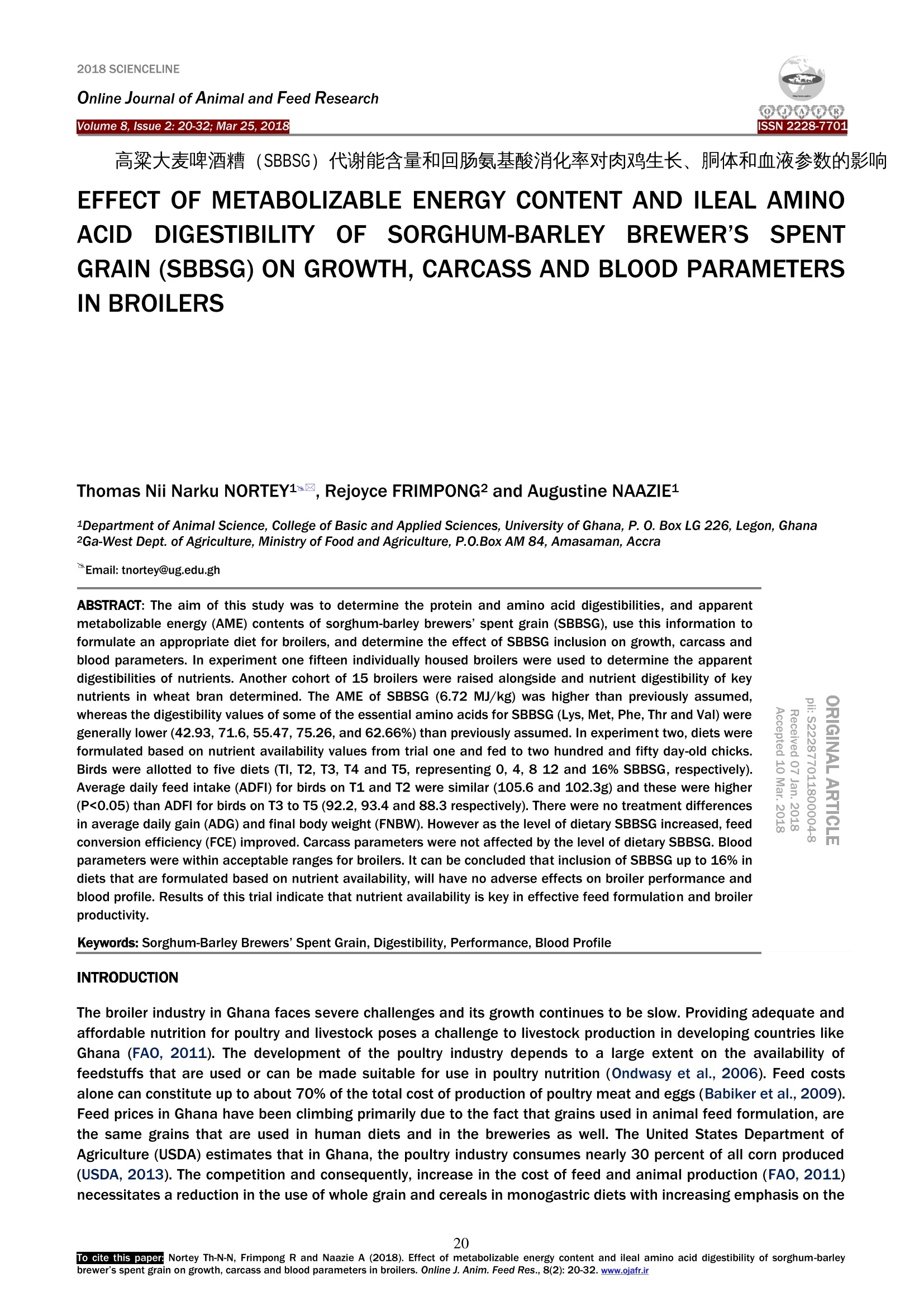
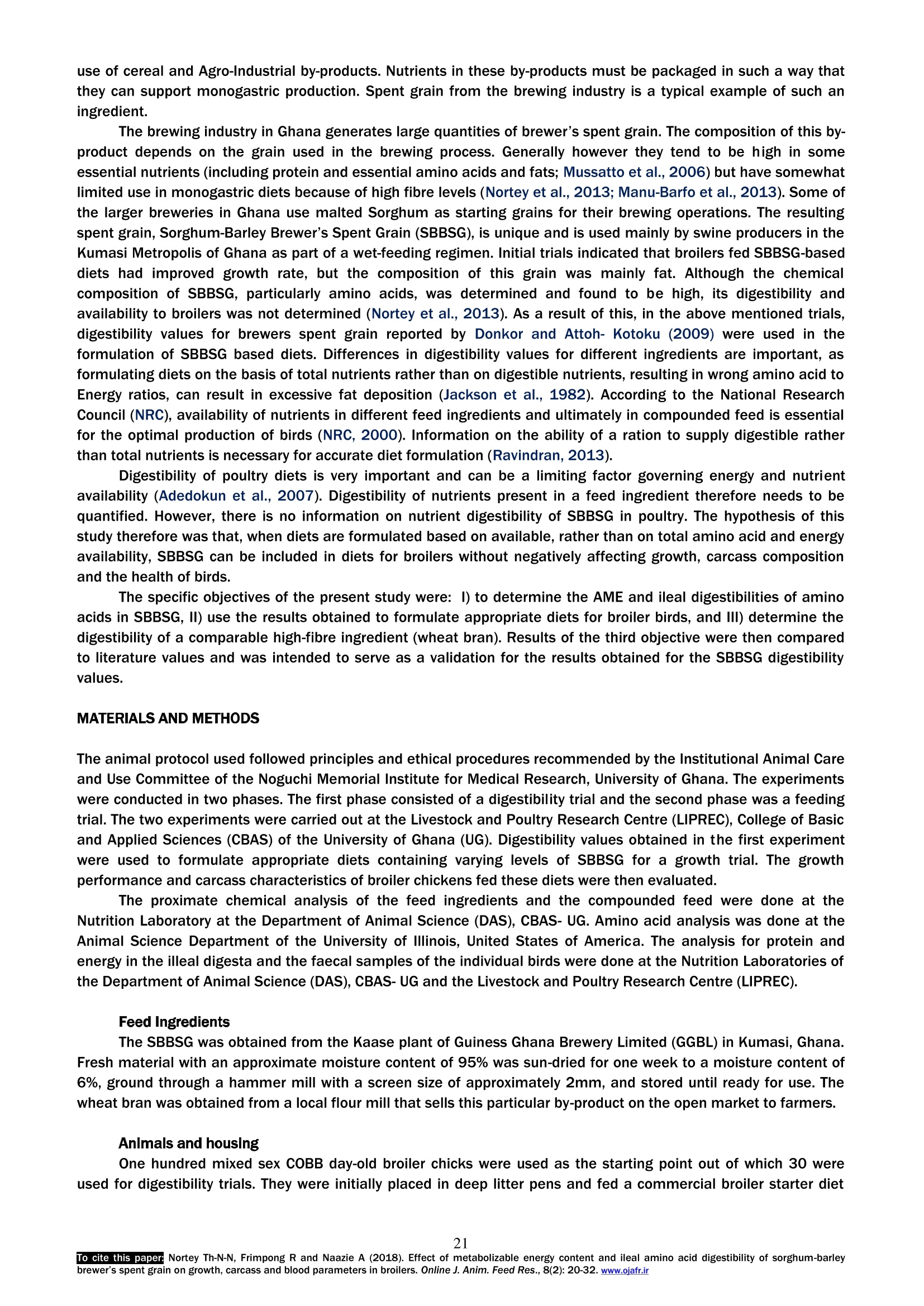
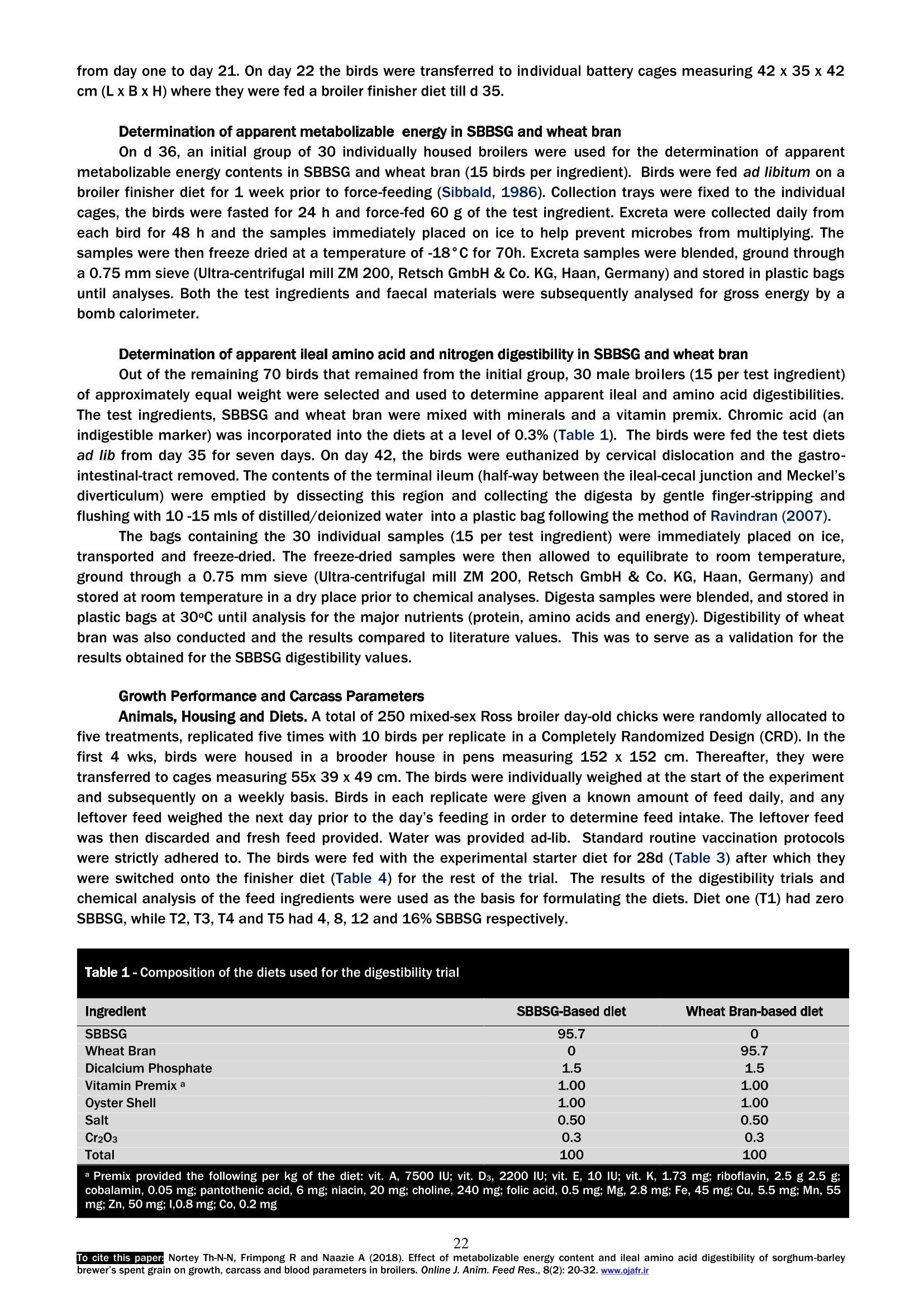
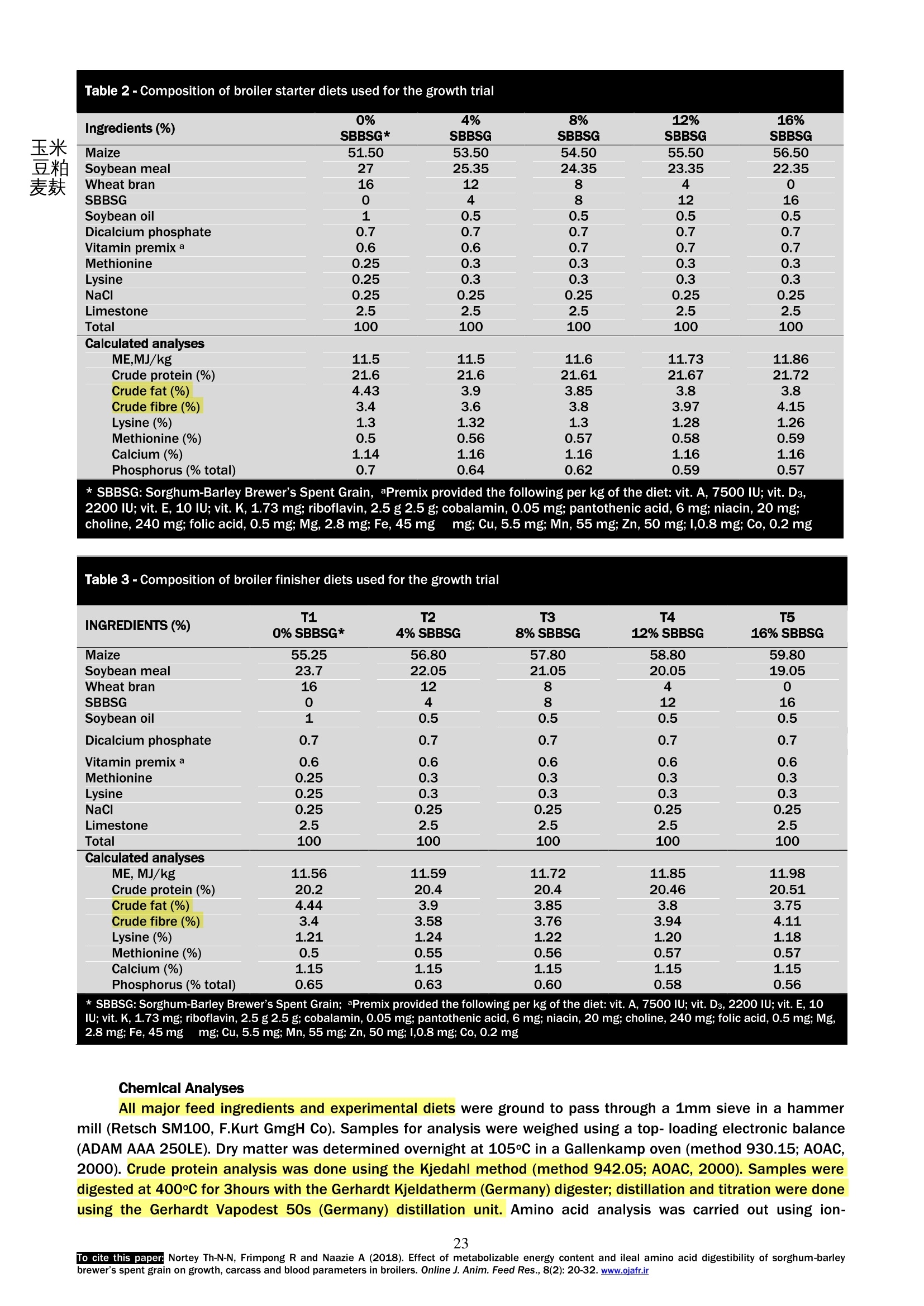
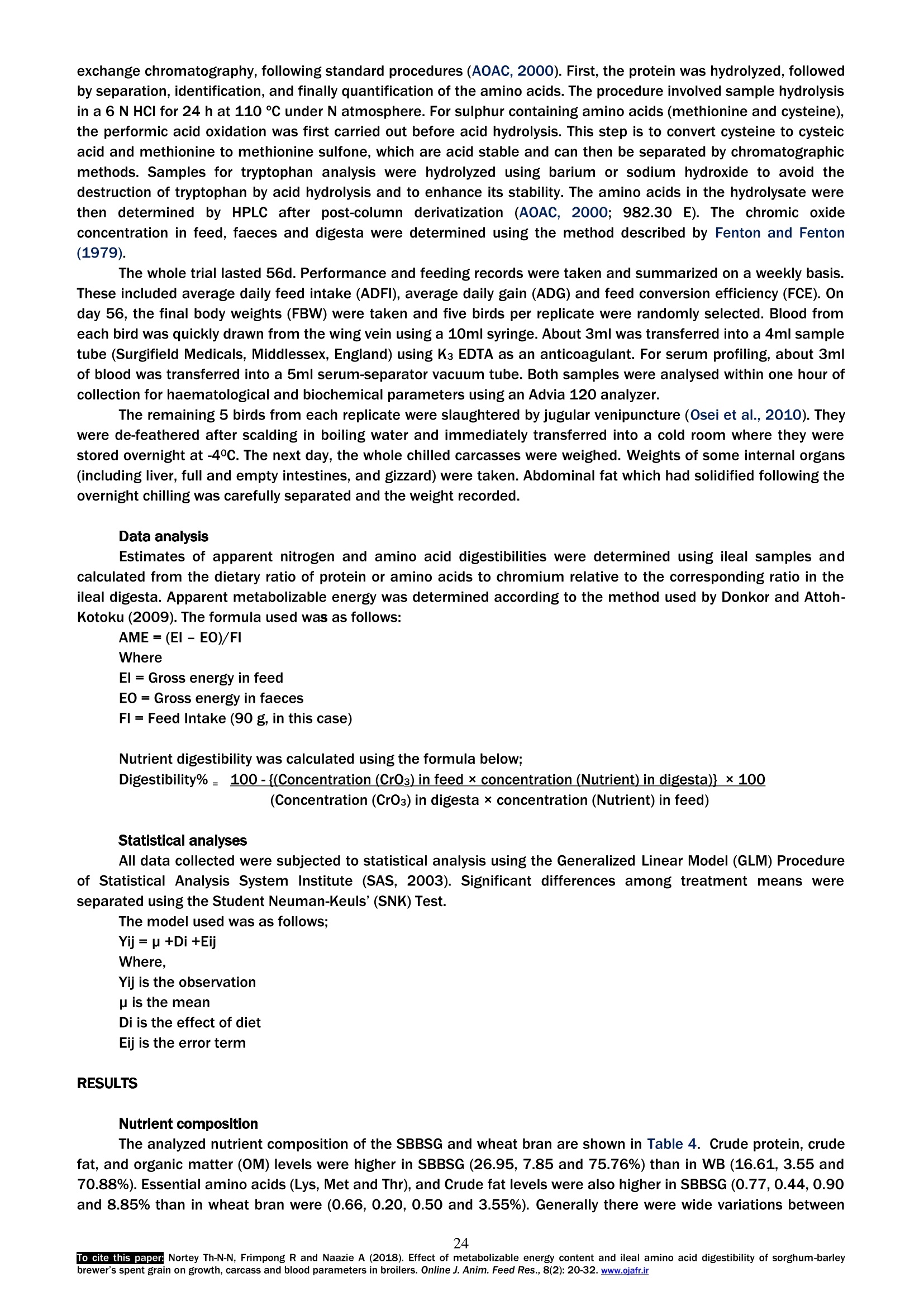
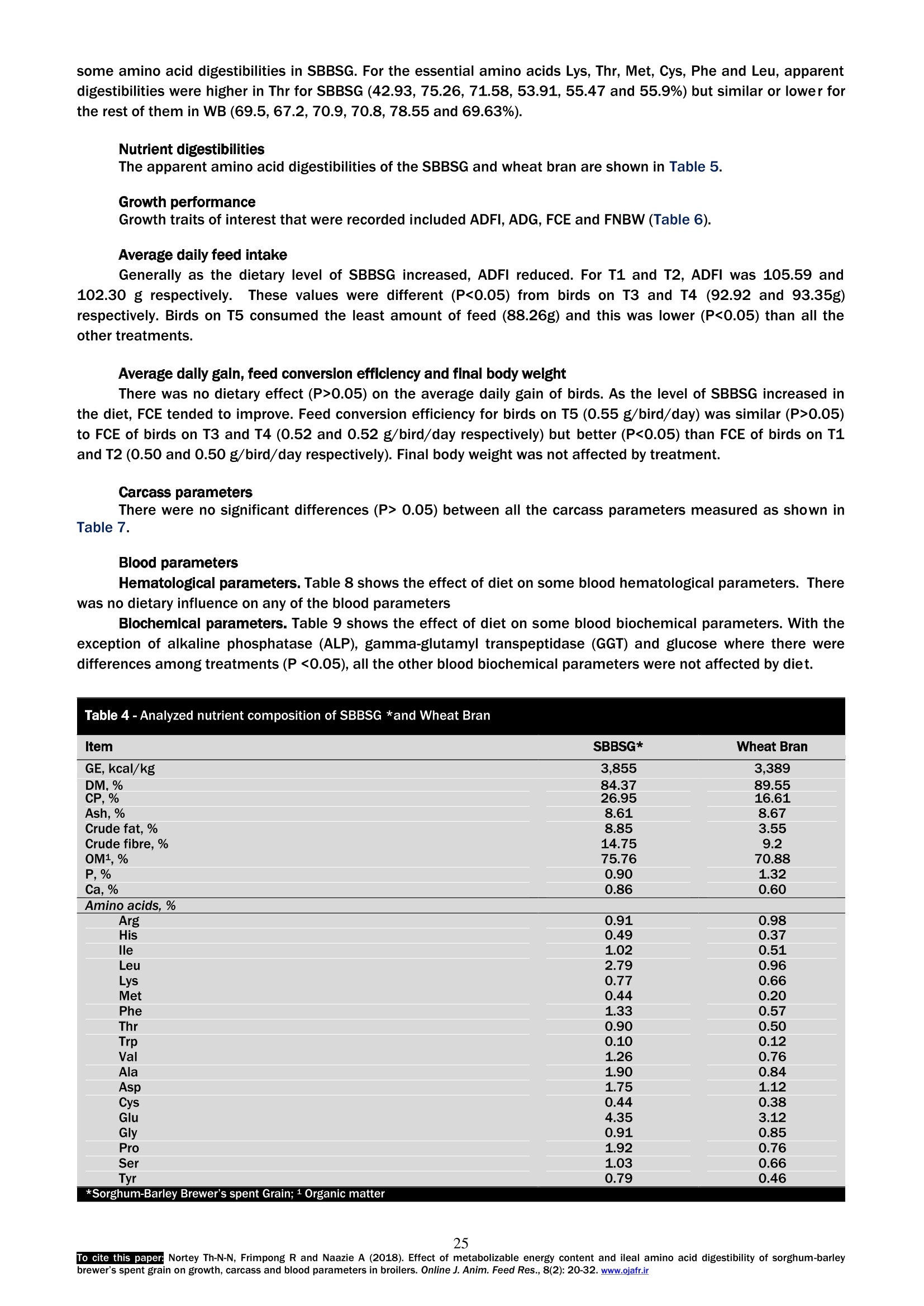
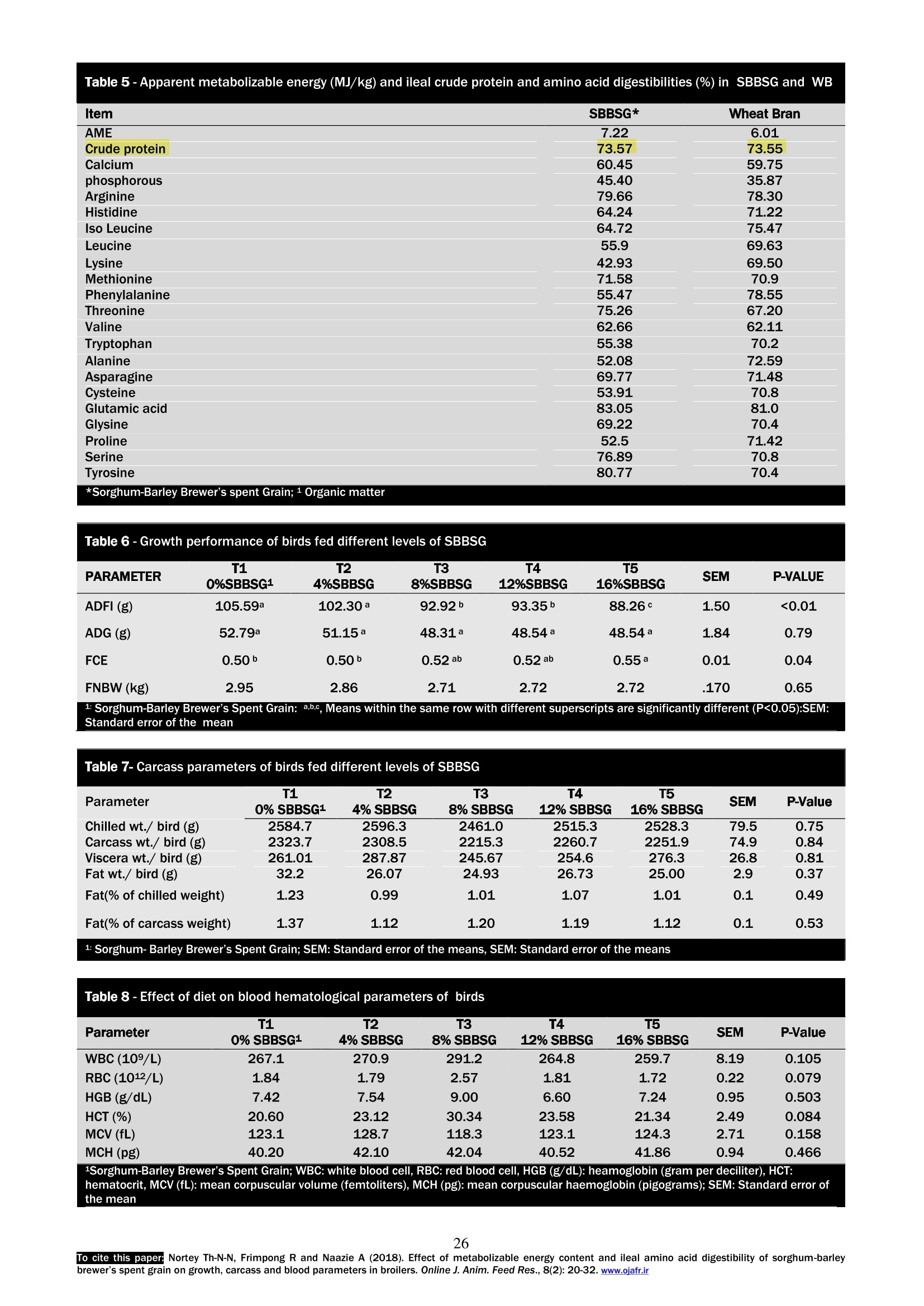
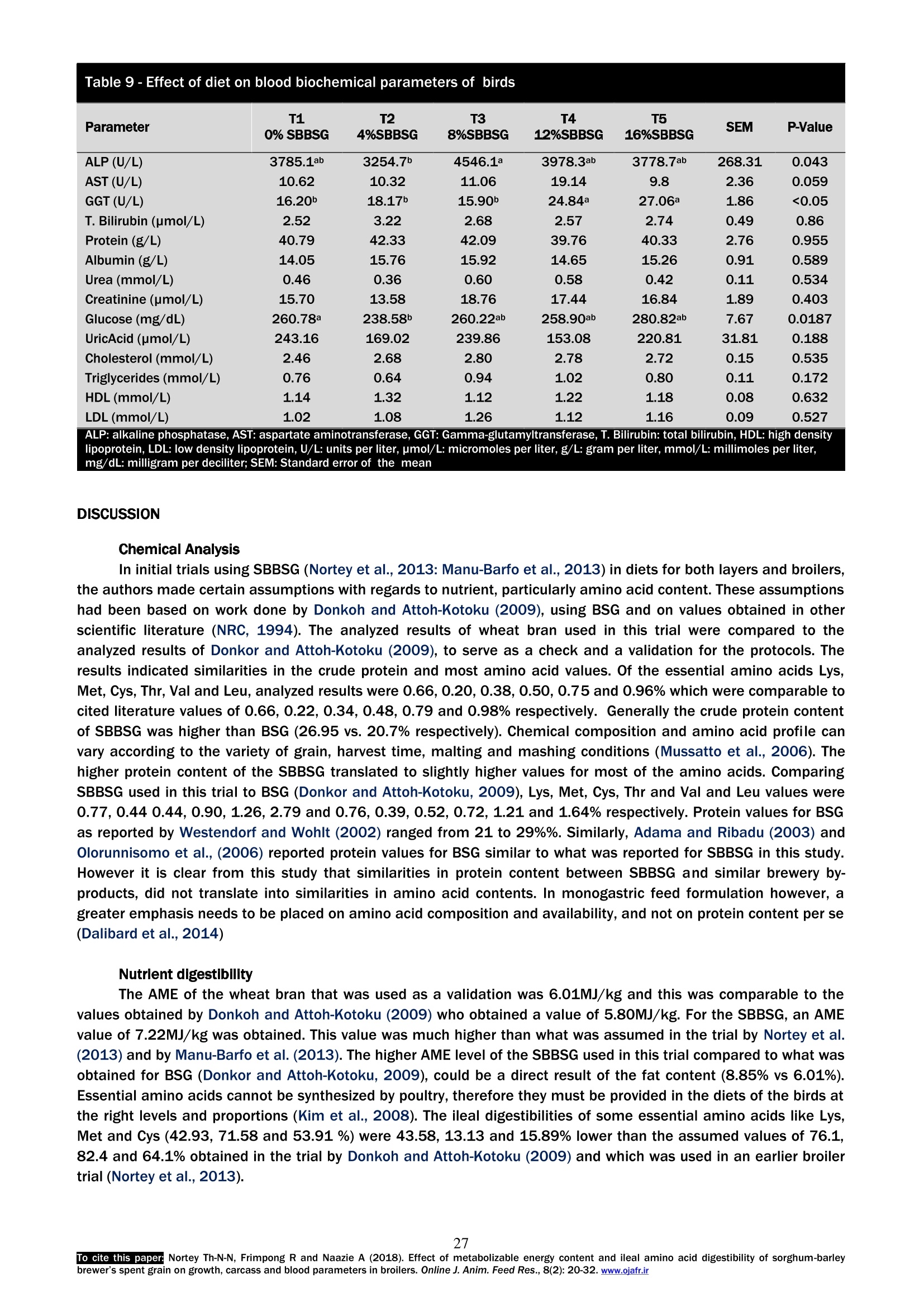
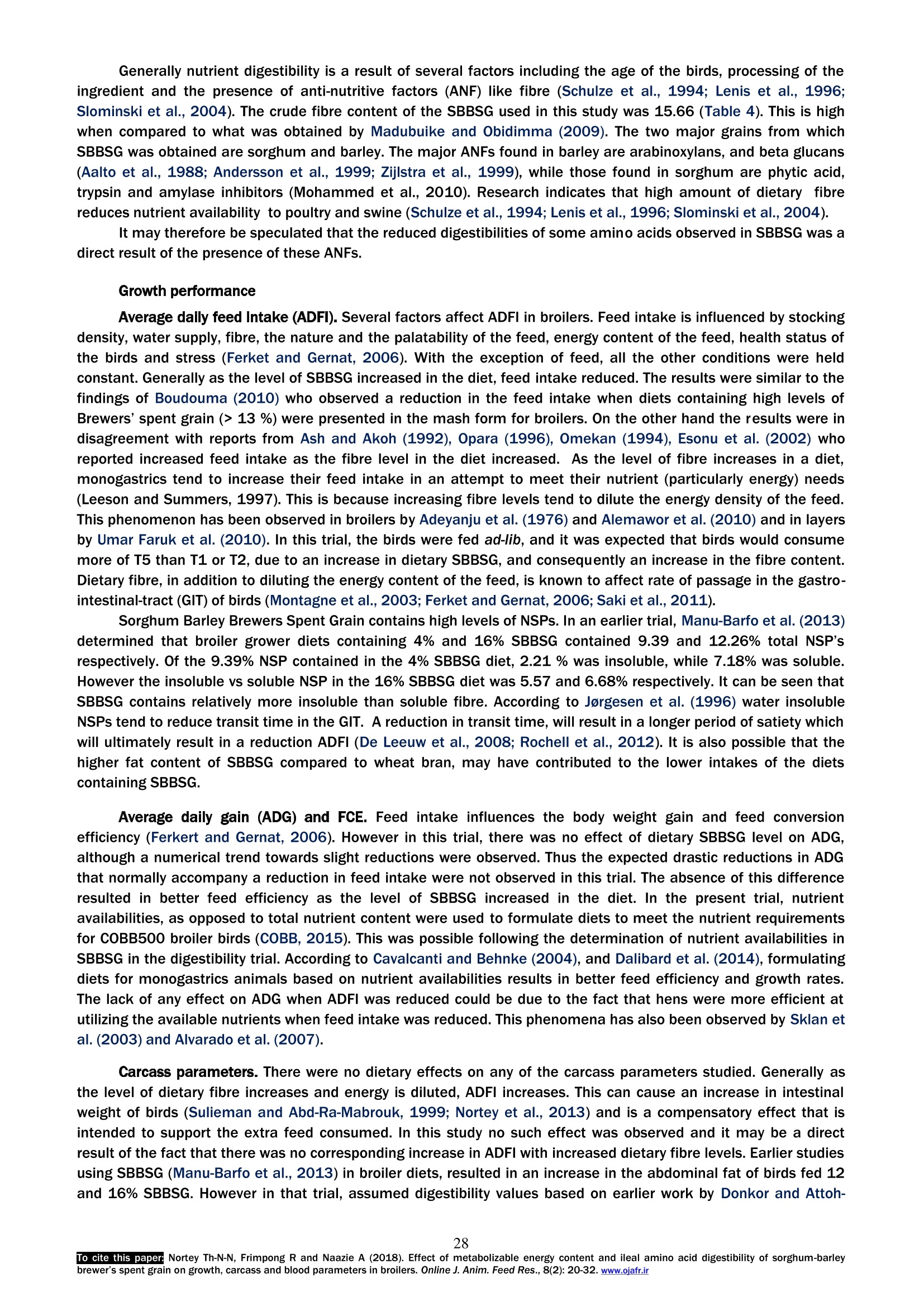
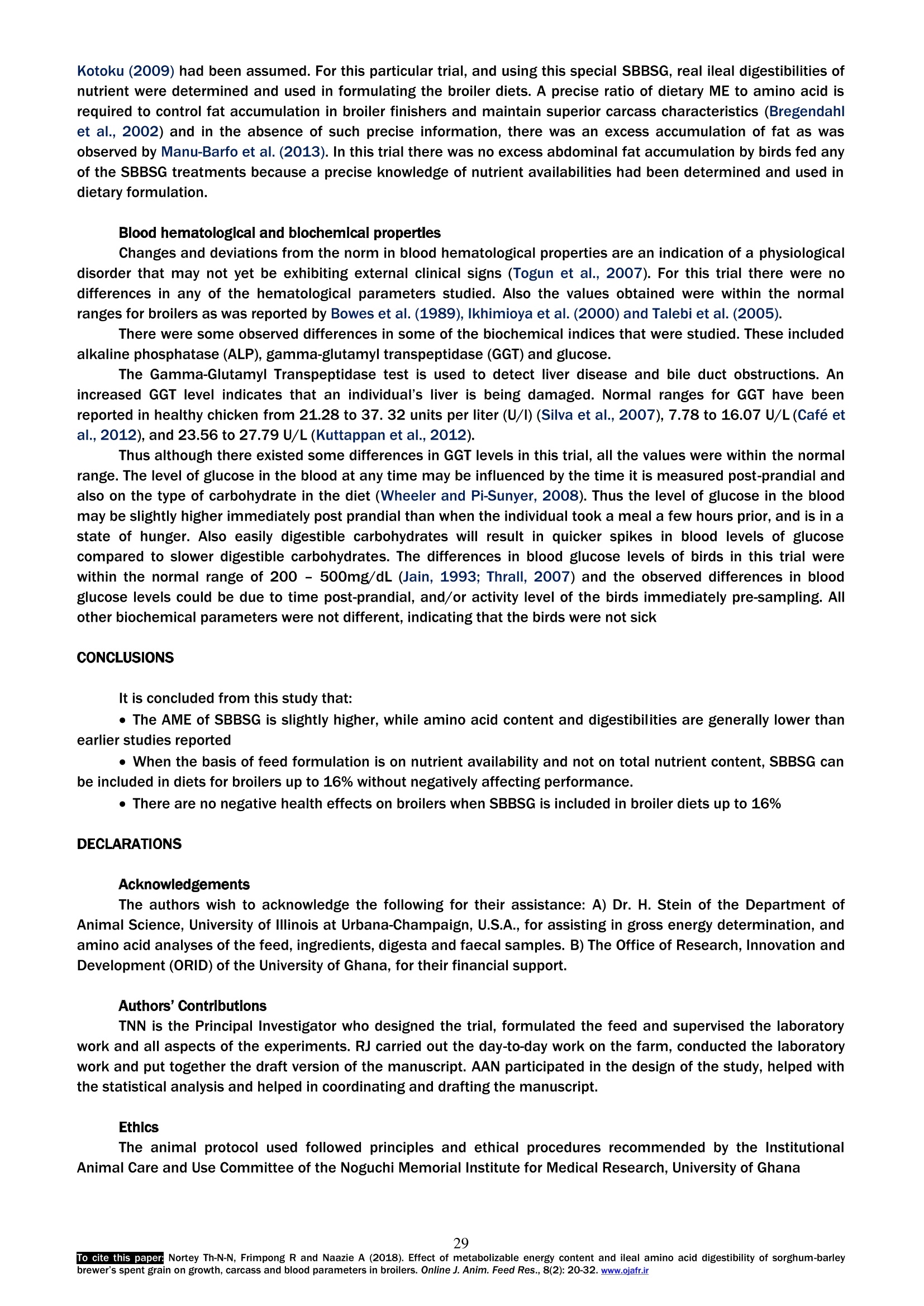


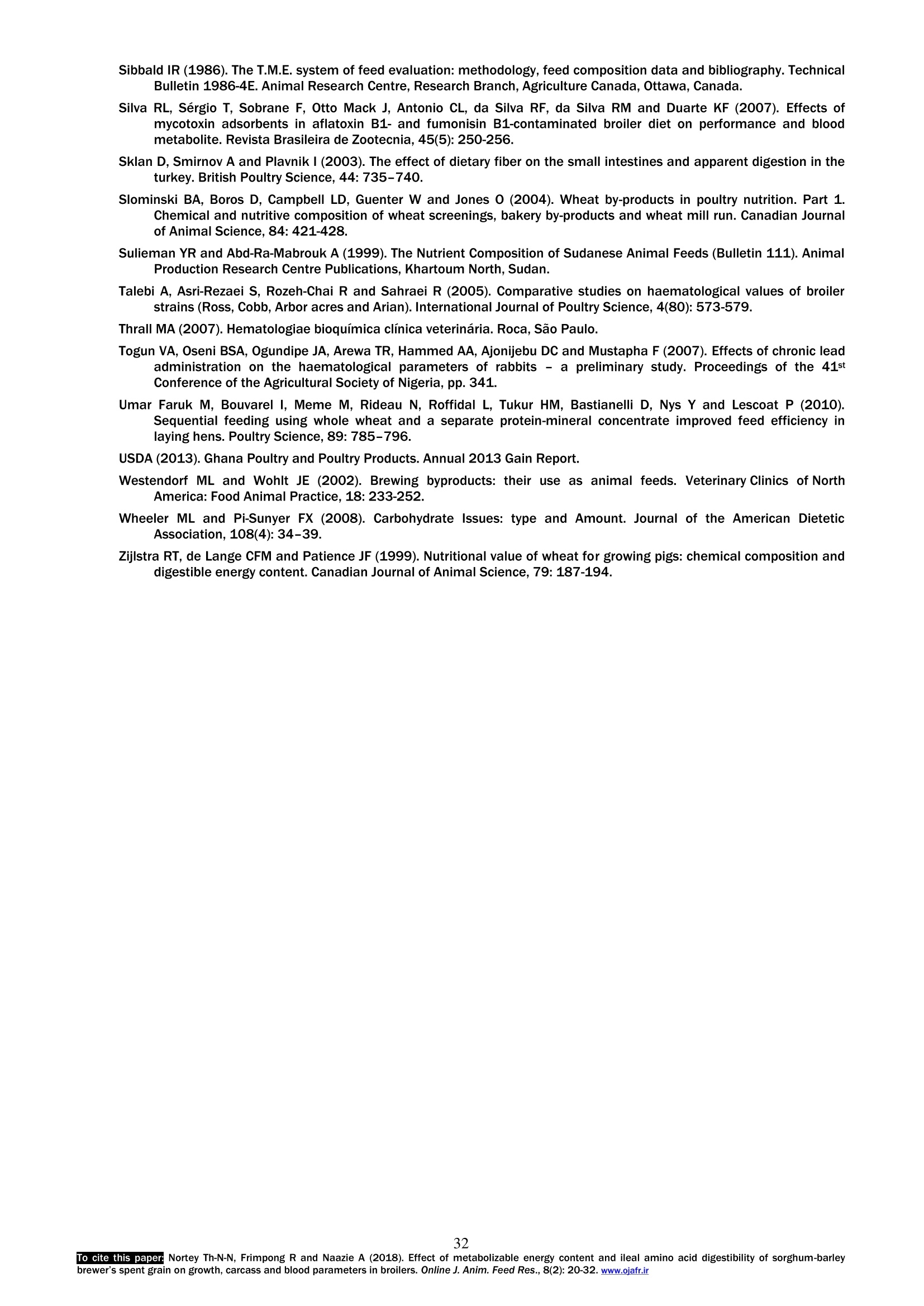
还剩11页未读,是否继续阅读?
中国格哈特为您提供《高粱大麦啤酒糟(SBBSG)和麦麸蛋白质消化率,高粱大麦啤酒糟(SBBSG)、玉米、豆粕、麦麸蛋白质脂肪及粗纤维含量的测定》,该方案主要用于饲料中营养成分检测,参考标准--,《高粱大麦啤酒糟(SBBSG)和麦麸蛋白质消化率,高粱大麦啤酒糟(SBBSG)、玉米、豆粕、麦麸蛋白质脂肪及粗纤维含量的测定》用到的仪器有格哈特带自动进样器凯氏定氮仪VAP500C、格哈特自动升降凯氏定氮电热消解仪KT-L 20s、格哈特全自动快速索氏提取SOXTHERM、格哈特全自动型纤维分析仪FT12、格哈特维克松废气实验室废物处理系统涤气VS、凯氏定氮催化片、德国移液器MM
相关方案
更多
该厂商其他方案
更多













